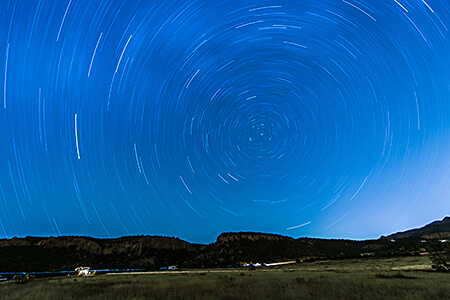
Star trails are just plain cool, and with the incredible noise performance of today’s cameras, all you have to do is point and shoot. One technique involves shooting around ISO 3200, 25 seconds at F4…this should put you close to the correct exposure without any star movement if you are using a wide angle lens.
The other technique is to shoot a long exposure, 45 minutes or longer, and create star trails. I like to locate the north star as a rotation point, and also include the landscape in my image to create a more interesting composition. There are two ways to shoot the long shot; one long exposure or stacking shorter exposures to create a similar effect. The advantage of the long exposure is all you do is lock open your shutter using the ‘bulb’ setting and a cable release. Turn on your long exposure noise reduction and take the shot. With in camera noise reduction set, your camera will process the image as long as the exposure…so a one hour shot will process for an hour (two hours before you get to see the image). With the incredible noise performance of cameras, you should get a great image.

The second technique is shooting multiple short exposures and stacking them together in photoshop or using third party software. The advantage is you have less noise in these images, and you can also do some cool processing techniques when you stack the images together. The image above was stacked using Advanced Stacker Plus in photoshop, using the ‘Comet’ method. This adds a comet effect to the final image. The mountains were illuminated by the lights of Las Vegas.